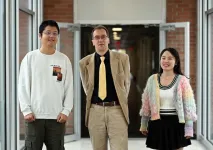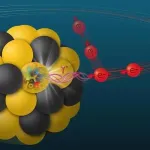(Press-News.org) UPTON, N.Y. — Nuclear physics theorists at the U.S. Department of Energy’s (DOE) Brookhaven National Laboratory have demonstrated that complex calculations run on supercomputers can accurately predict the distribution of electric charges in mesons, particles made of a quark and an antiquark. Scientists are keen to learn more about mesons — and the whole class of particles made of quarks, collectively known as hadrons — in high-energy experiments at the future Electron-Ion Collider (EIC), a particle collider being built at Brookhaven Lab. The predictions and measurements at the EIC will reveal how quarks and the gluons that hold them together in hadrons generate the mass and structure of nearly all visible matter.
“The fundamental science goal of the EIC is to understand how the properties of hadrons, including mesons and more familiar protons and neutrons, arise from the distributions of their constituent quarks and gluons,” said Brookhaven Lab theorist Swagato Mukherjee, who led the research. The lightest meson, the pion, plays an essential role in the nuclear strong force, which binds protons and neutrons in atomic nuclei. By probing the mysteries of pions, protons, and other hadrons, the EIC will help scientists unravel how everything made of atoms sticks together the way it does.
The new predictions, just published in Physical Review Letters, match nicely with measurements from low-energy experiments at DOE’s Thomas Jefferson National Accelerator Facility (Jefferson Lab), Brookhaven’s partner in building the EIC, and extend into the high-energy regime planned for experiments at the new facility. These predictions are important because they will provide a basis for comparison when the EIC experiments begin in the early 2030s.
But the findings go further than establishing expectations for a single EIC measurement. As described in the paper, the scientists used their predictions — together with additional independent supercomputer calculations — to validate a widely used approach for deciphering particle properties. This approach, known as factorization, breaks complex physical processes into two components, or factors. Validation of factorization will enable many more EIC predictions and more confident interpretations of experimental results.
Peering into hadrons
To probe the inner makeup of hadrons, the EIC will collide high-energy electrons with either protons or atomic nuclei. Virtual photons, or particles of light, emitted from the electron help reveal the properties of the hadron — sort of like a microscope for the building blocks of matter.
Collisions at the EIC will provide precise measurements of various physical scattering processes. To transform these precise measurements into high-resolution images of the building blocks of matter within hadrons, scientists rely on factorization. This theoretical approach breaks the experimental measurement — for example, the distribution of electric charges in mesons — into two components so scientists can use knowledge of two parts of the process to infer information about the third.
Think of a mathematical equation where X = Y × Z. The full value, X — the experimental measurement — can be made up of two factors, Y and Z. One factor, Y, describes how quarks and gluons are distributed inside the hadron. The other factor, Z, describes the interactions of those quarks and gluons with the high-energy virtual photon emitted by the colliding electron.
The quark/gluon distributions are very difficult to calculate because of the strong interactions between quarks and gluons inside a hadron. Those calculations contain billions of variables described by the theory of the strong interaction, known as quantum chromodynamics (QCD). Solving QCD equations typically requires simulating the interactions on an imaginary space-time lattice using powerful supercomputers.
The interactions of quarks and gluons with the virtual photon, on the other hand, are relatively weak. So, theorists can use “pen-on-paper” calculations to derive those values. They can then use these simple calculations combined with the experimental measurements (or predicted measurements) — and the mathematical relationship between those factors — to solve the equation and arrive at a view of the distribution of quarks and gluons inside hadrons.
“But does this actually work — separating one phenomenon into these two factors?” asked Qi Shi, a visiting graduate student in Brookhaven Lab’s Nuclear Theory Group. “We needed to prove that it does.”
To do that, the scientists ran factorization in reverse. “We turned it around,” Shi said.
Shi and Xiang Gao, a postdoctoral researcher in the group, used supercomputers and space-time lattice simulations to calculate the quark-antiquark distributions in the mesons (Y, in the equation above). Then they used the simpler “pen-on-paper” calculations of the quark/gluon interactions with photons (Z) and did the math to find the predicted value for the experimental measurement (X) — the charge distribution inside mesons.
Finally, the scientists compared these new predictions with the ones they’d done using a separate supercomputer calculation — the ones that matched the Jefferson Lab measurements at low energy. By comparing the two predictions — one calculated using factorization and one computed independently using the lattice simulation approach — they could test whether factorization is a valid way to solve such problems.
The reverse factorization calculations matched their supercomputer-calculated predictions perfectly.
“In this case, we can fully compute everything using the lattice,” Shi said. “We chose this specific case because we can calculate both the left- and the right-hand sides of the equation using independent calculations to show that factorization works.”
Now, scientists can use factorization to predict and analyze other EIC observables, even when one side cannot be calculated directly.
“This work shows that the factorization approach works,” said Peter Petreczky, the group leader and a co-author of the paper. “Scientists can now make use of future EIC data and factorization to infer other more complex quark and gluon distributions in hadrons that cannot be calculated — even using the most powerful computers and sophisticated techniques.”
This research was supported by the DOE Office of Science (NP) and used awards of computer time at the Argonne Leadership Computing Facility, the Oak Ridge Leadership Computing Facility, and the National Energy Research Scientific Computing Center — all DOE Office of Science user facilities at DOE’s Argonne National Laboratory, DOE’s Oak Ridge National Laboratory, and DOE’s Lawrence Berkeley National Laboratory, respectively. Computations were also carried out in part on facilities of the US Lattice Quantum Chromodynamics (USQCD) Collaboration.
Brookhaven National Laboratory is supported by the Office of Science of the U.S. Department of Energy. The Office of Science is the single largest supporter of basic research in the physical sciences in the United States and is working to address some of the most pressing challenges of our time. For more information, visit science.energy.gov.
Follow @BrookhavenLab on social media. Find us on Instagram, LinkedIn, X, and Facebook.
Related Links
Scientific paper: "QCD Predictions for Meson Electromagnetic Form Factors at High Momenta: Testing Factorization in Exclusive Processes" END
Scientists calculate predictions for meson measurements
Theorists' calculate charge distributions in mesons, validate method for imaging building blocks of matter
2024-11-06
ELSE PRESS RELEASES FROM THIS DATE:
Mayo Clinic researchers recommend alternatives to hysterectomy for uterine fibroids, according to study
2024-11-06
ROCHESTER, Minn. — Uterine fibroids are a common condition that affects up to 80% of women in their lifetime. Nearly half of those women will experience symptoms that affect their quality of life and fertility, including severe pain and anemia. Uterine fibroids are the major reason for the removal of the uterus by hysterectomy. However, Mayo Clinic researchers recommend minimally invasive treatment alternatives to hysterectomy, in an invited clinical practice paper published in the New England Journal of Medicine.
"Less invasive ...
Using a fan and wetting the skin reduces risk of deadly cardiac strain in hot and humid weather
2024-11-06
Using a fan and wetting the skin reduces risk of deadly cardiac strain in hot and humid weather
But older people should avoid using fans in very hot and dry conditions
New collaborative research from the University of Sydney and the Montreal Heart Institute has shown that using a fan in hot and humid weather reduces cardiac strain in older people, contradicting recommendations from the Centers of Disease Control and Prevention in the US.
The study, funded by the National Health and Medical Research Council (NHMRC) ...
Very early medication abortion is effective and safe
2024-11-06
Clinics and hospitals currently defer medication abortion until ultrasound confirms a pregnancy inside the uterus. However, a large international study led by researchers from Karolinska Institutet now indicates that treatment can be equally effective and safe even before the sixth week of pregnancy. The study is published in The New England Journal of Medicine.
35,550 abortions took place in Sweden in 2023, over 60 per cent of them before the end of the seventh week of pregnancy. Often, the procedure is held off until intrauterine pregnancy is confirmed by vaginal ultrasound to rule out the possibility of an ectopic pregnancy, in which the embryo attaches ...
Sleepiness during the day may be tied to pre-dementia syndrome
2024-11-06
EMBARGOED FOR RELEASE UNTIL 4 P.M. ET, WEDNESDAY, NOVEMBER 6, 2024
MINNEAPOLIS – Older people who are sleepy during the day or lack enthusiasm for activities due to sleep issues may be more likely to develop a syndrome that can lead to dementia, according to a study published in the November 6, 2024, online issue of Neurology®, the medical journal of the American Academy of Neurology.
People with the syndrome have a slow walking speed and say they have some memory issues, although they do not have a mobility disability or dementia. Called motoric cognitive risk ...
Research Spotlight: Higher brain care score found to improve brain health regardless of genetic risk
2024-11-06
Christopher D. Anderson, MD, MSc, chief of the Division of Stroke and Cerebrovascular Diseases at Brigham and Women’s Hospital and associate neurologist in the Department of Neurology and Center for Genomic Medicine at Massachusetts General Hospital, is the corresponding author and Jonathan Rosand, MD, MSc, co-founder of the McCance Center for Brain Health and neurologist in the Department of Neurology and Center for Genomic Medicine at Massachusetts General Hospital, is an author of a paper published on November 6, 2024, in Neurology®, the medical journal of the American Academy of Neurology, “Health-related behaviors ...
Variation in the measurement of sexual orientations is associated with sexual orientation-related mental health disparities
2024-11-06
Sexual orientation—dictated by factors like sexual identity, attraction and behavior—is challenging to measure comprehensively. This is reflected in variations in the number of lesbian, gay, bisexual and transgender people recorded across surveys using different measurement approaches. Most approaches focus on ‘sexual identity’ to understand mental health disparities, but differences in perceived notions of ‘identity’ and ‘attraction/behavior’ are prevalent. For instance, some ...
Study shows how high blood sugar increases risk of thrombosis
2024-11-06
A study conducted at the Center for Research on Redox Processes in Biomedicine (Redoxoma) helps understand how high blood sugar (hyperglycemia), one of the manifestations of diabetes, can cause thrombosis. The findings, reported in an article published in the Journal of Thrombosis and Haemostasis, can contribute to the development of strategies to prevent cardiovascular dysfunction in diabetics.
“The leading causes of death in Brazil and several other Latin American countries ...
Cachexia decoded: Why diagnosis matters in cancer survival
2024-11-06
Maintaining good health and well-being is crucial for how well patients respond to cancer treatments. Unfortunately, cachexia, or involuntary weight loss, is a major concern for many individuals with advanced cancer. A new study from Japan has revealed that lower cachexia rates, particularly with prevalence less than 40–50%, are linked to shorter overall survival (OS) rates. The study also showed that the diagnostic criteria used for cachexia detection can affect the reported cachexia prevalence.
People with advanced heart disease or cancer often face serious health challenges. Cachexia, an involuntary loss ...
Transportation institute awarded nearly $1 million in trucking education grants
2024-11-06
Safety is not only for truck drivers, but also the drivers around them.
The Virginia Tech Transportation Institute recently received nearly $1 million in two grants from the U.S. Department of Transportation’s Federal Motor Carrier Safety Administration to develop and enhance tractor-trailer educational programs.
“These two grants will allow us to continue transforming our research into practice,” said Rich Hanowski, director of the institute's division of freight, transit, and heavy vehicle safety. “The outreach initiatives will directly leave an impact on drivers ...
Sewage surveillance proves powerful in combating antimicrobial resistance
2024-11-06
Waterborne diseases affect over 7 million people in the U.S. every year, according to the Centers for Disease Control and Prevention, and cost our health care system over $3 billion. But they don’t impact all people equally.
A campuswide collaboration is using sewage surveillance as a vital strategy in the fight against diseases that spread through the water such as legionella and shigella. The ones that are most difficult to combat are diseases with antimicrobial resistance, which means they are able to survive against antibiotics that are intended to kill them.
A recent paper in Nature Water offers an encouraging insight: Monitoring ...
LAST 30 PRESS RELEASES:
Korea University researchers discover that cholesterol-lowering drug can overcome chemotherapy resistance in triple-negative breast cancer
Ushikuvirus: A newly discovered giant virus may offer clues to the origin of life
Boosting the cell’s own cleanup
Movement matters: Light activity led to better survival in diabetes, heart, kidney disease
Method developed to identify best treatment combinations for glioblastoma based on unique cellular targets
Self-guided behavioral app helps children with epilepsy sleep earlier
Higher consumption of food preservatives is associated with an increased risk of type 2 diabetes
NTU Singapore-led team captures first-ever ‘twitch’ of the eye’s night-vision cells as they detect light, paving the way for earlier detection of blindness-causing diseases
Global aviation emissions could be halved through maximising efficiency gains, new study shows
Fewer layovers, better-connected airports, more firm growth
Exposure to natural light improves metabolic health
As we age, immune cells protect the spinal cord
New expert guidance urges caution before surgery for patients with treatment-resistant constipation
Solar hydrogen can now be produced efficiently without the scarce metal platinum
Sleeping in on weekends may help boost teens’ mental health
Study: Teens use cellphones for an hour a day at school
After more than two years of war, Palestinian children are hungry, denied education and “like the living dead”
The untold story of life with Prader-Willi syndrome - according to the siblings who live it
How the parasite that ‘gave up sex’ found more hosts – and why its victory won’t last
When is it time to jump? The boiling frog problem of AI use in physics education
Twitter data reveals partisan divide in understanding why pollen season's getting worse
AI is quick but risky for updating old software
Revolutionizing biosecurity: new multi-omics framework to transform invasive species management
From ancient herb to modern medicine: new review unveils the multi-targeted healing potential of Borago officinalis
Building a global scientific community: Biological Diversity Journal announces dual recruitment of Editorial Board and Youth Editorial Board members
Microbes that break down antibiotics help protect ecosystems under drug pollution
Smart biochar that remembers pollutants offers a new way to clean water and recycle biomass
Rice genes matter more than domestication in shaping plant microbiomes
Ticking time bomb: Some farmers report as many as 70 tick encounters over a 6-month period
Turning garden and crop waste into plastics
[Press-News.org] Scientists calculate predictions for meson measurementsTheorists' calculate charge distributions in mesons, validate method for imaging building blocks of matter





